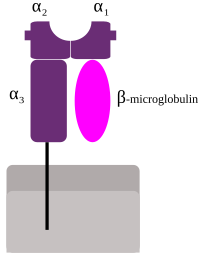
Photo from wikipedia
Renal transplant candidates with more than 99% CPRA are at greater disadvantage for a match run. Even with a match-run, some of the allelic DSAs not used for Unacceptable Antigens… Click to show full abstract
Renal transplant candidates with more than 99% CPRA are at greater disadvantage for a match run. Even with a match-run, some of the allelic DSAs not used for Unacceptable Antigens [UA] entry criteria, could make the decision to import an organ from a distant location difficult without knowing the donor’s allele level typing. We describe the case of a patient where the first potential importable organ had to be rejected and the second one could be accepted leading to a successful transplant based on inferred 2 field HLA typing information of the donor. Case: Patient JG, a 24 year old female with a hx of ESRD secondary to pauci-immune glomerulonephritis with a kidney txp in 2001 that failed in 2012 with >99% CPRA got an import kidney offer in Aug 2017 for a donor with an HLA Genotype of A68/-; B35, 39; C1, 7; and DRB1 *0401/04/02/03 at both HLA-DRB1 Loci. The Recipient had strong antibody to DRB1*04:02 [MFI 7000 consistently]and B39MFI = 3117. Since the donor had a potential DRB1*04:02 on both DR4 loci and a B39, the offer was rejected. HLA-DR4 could not be entered as UA despite a high MFI value since listed patient was DRB1*04:01/*04:07. Another offer came through and the donor had a DRB1*04 but the most possible alleles were depicted as DRB1*04: 03/*04:07 and DRB1*04:02 was not an option. So the only HLA DSA the patient had towards this donor was B39 [MFI = 3117]; Accepted the organ and the real cross match was negative, the transplant was done and the Recipient is doing well as of now. Allele-specific antibodies and their impact on real cross matches have been highlighted by failed NKR Chains not knowing allele specific DSAs. Also, when a patient is listed as DRB1*04, we cannot list any UAs as DR4. And as we propagate our ability to assign antibody specificity based on the single antigen bead based assays, we are still at large with allele-specific antibodies that could be crucial. We have an example of a case where the Recipient had antibodies against B*35:01 and DRB1*14:01/02/54; and had a donor with B*35:12 and DRB1*14:07 -And No beads to assess antibodies against B*35:12 or DRB1*14:07. Conclusion: Virtual crossmatch can be an excellent tool as long as we have reliable data on DSAs in terms of the allele-specific antibodies where applicable, and it is extremely important when one make decision to import an organ based on potential allele-specific DSAs.
Journal Title: Human Immunology
Year Published: 2018
Link to full text (if available)
Share on Social Media: Sign Up to like & get
recommendations!